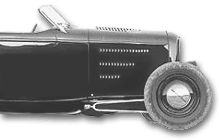
|
Hot rods and alternative fuel I'm building a 1931 Ford hot rod roadster that will run on liquefied petroleum gas (LPG), usually referred to as propane. The goal of this project is simple: I want a fast, rumbly, wind-in-your-hair V8 hot rod that's a hoot to drive but also meets current emissions standards. There's lots of exhaustive—no pun intended—detail on how I plan to accomplish this below if you're interested. But first, let's meet the roadster. The plan This concept drawing, illustrated by my friend Jimmy Smith, shows what the roadster will look like when completed: This particular roadster is heavily influenced by a '32 Ford roadster built in the 40's by Doane Spencer. The Spencer car is considered a classic among old hot rod guys, and with good reason—it's arguably one of the best looking hot rods ever built. A bit of housekeeping: If you've been to this site before you might be a little confused, because I previously described my project as a '31 roadster on a '32 frame, which then morphed into a '32 Ford roadster pickup. Well, things have come full circle and I'm now back to the original plan of a '31 roadster on '32 rails. This time the decision is final. No, really. I mean it. The Details The chassis is based on a reproduction of a 1932 Ford frame, while the body is a '31 sport coupe body that will be modified to match model A roadster dimensions. The roadster will forego fenders in order to reduce weight and capture that old-time look. The engine is a '67 Ford 289 V8, set up with aluminum heads and given a performance rebuild optimized for gaseous fuel. The transmission will be a 5-speed manual nicked from a '92 Mustang. Black steel wheels capped with '46 Ford hubcaps sit on all four corners, and the windshield will be a v-style DuVal design. Current progress Here's a couple of old (8/13/03) construction photos of the roadster. The front and rear suspension are in, and the chassis is rolling on black steel wheels with '46 Ford hubcaps. I just finished rebuilding the 289 engine in January 2005, and the T5 transmission is ready to go. Soon I will begin plotting the body modifications with Gordon of Gordini's Garage in Fremont.
Why would anyone want to do this? There's actually a borderline rational explanation for why someone would build a hot rod version of a car that has been obsolete for over 70 years, then power it with an alternative fuel. In my case, I've always liked old hot rods—my first car was a 1940 Ford coupe with a dual-carb flathead V8—and I'm also interested in alternative fuels and cleaner sources of energy in general. I decided to combine these two interests.
And there's the rub. Being a lifelong breather of air I have one foot in the environmentalist camp, but a lot of those guys look at cars solely as transportation. They seem to subscribe to the "suck the joy out of cars" theory of progress, and many of them think that we'll all be happier once we simply abandon our fixation on the automobile. Uh, yeah, I'll get right on that. Hey, I've got friends in both camps, and I'm not out to convert them. But personally, I'd like to chase a third option—a have your cake and eat it too option—that might also appeal to anyone with interests similar to mine.
Well, that and to have a bitchin roadster to blast around town in. "Why propane? Isn't propane for (snicker) barbecue grills and fork lifts?" Like I've never heard that one before. Actually, the three most widely-used motor vehicle fuels are gasoline, diesel, and propane, in that order. Gasoline is the obvious front runner in terms of market share, and everyone knows about big diesel trucks (not to mention probably having been stuck gasping behind a smoky diesel passenger car at some point.)
But fuel cost is not the primary motivation for this project. Here are some of the advantages of propane compared to gasoline:
The last point is a timely one. Propane requires less dependence on foreign oil because it can be made from either oil or natural gas. The United States has large reserves of natural gas, and could produce much of the propane required to power the country's automobiles. "But isn't propane dangerous?"
"Propane production is still dependent on non-renewable resources. Why not use ethanol or hydrogen instead?" The primary issue with either of those otherwise excellent motor fuels is the availability—or lack thereof—of filling stations. There simply aren't any ethanol E85 filling stations in California. While it'd be fun to build my own ethanol still, I don't have the real estate to undertake such a venture. Meanwhile, hydrogen can be found at two or three stations in California, but there is more research and work to be done before a hydrogen conversion is completely practical. The sheer size of the tanks required to have a practical 300 mile range is currently prohibitive, and hydrogen fuel cell technology is still in its infancy—not to mention expensive. (Interestingly, building a propane fuel car is a good dry rehearsal for a hydrogen fuel conversion—much of the theory and equipment will be similar or identical for a hydrogen fuel burning car.) On the other hand, a propane-powered car can be built affordably and fuel is available all across the United States. In a pinch, you can always pull in to the local U-Haul yard and fill up your tank there. You know, where you normally fill up the barbecue grill tank.
"I've heard that engines lose a bunch of horsepower when they are converted to run on propane." Propane has a bad rap because of some bad conversions and some knee-jerk conclusions drawn from textbook physics. First, the dry & boring physics of it all: The exact numbers seem to depend on which authoritative textbook you reference, but on average propane has about 25% less BTUs of energy per gallon than gasoline. So it stands to reason that you'd get 25% less horsepower on propane, all other things being equal. But there's the catch—all other things aren't equal. Liquid gasoline has to be atomized and mixed with air before it can be burned effectively in your engine. Engine builders know that in a carbureted engine a portion of that gasoline doesn't fully atomize and falls out of suspension, ending up in a puddle somewhere in the intake manifold. This is why the cylinders downhill from the carburetor tend to run richer than the others. (It's also one of the reasons why fuel-injected engines are more efficient than carbureted engines.)
Which brings us to the issue of naughty conversions. Propane engines require a different ignition advance curve compared to gasoline, typically advanced 5-15 degrees under 3,000 RPM. Additionally, propane has a higher octane rating than premium gasoline (about 105 compared to 91 or so), so you can build an engine with a higher compression ratio, making the engine even more efficient. The bottom line? An engine built with propane in mind can achieve roughly the same amount of horsepower—in some cases more—than a comparable gasoline carbureted engine. Stuff to check out Anyway, I'll be posting the latest construction photos as the build progresses. In the meantime, here are some other alternative fuel vehicles that don't suck the chrome off a DeSoto bumper:
|

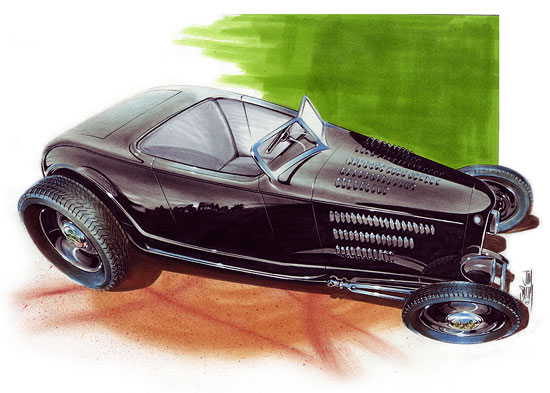
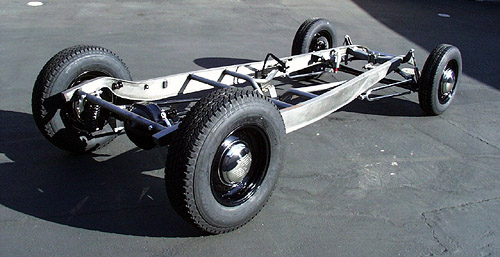
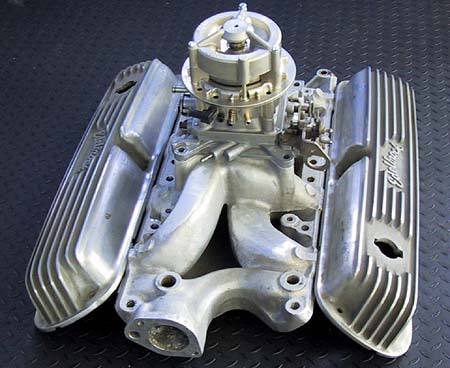
 Unfortunately, while the alternative fuel cars most people have seen demonstrate an admirable concern for the environment, they are almost always gutless, boxy things. To a car enthusiast, they almost seem like vehicles designed by people who hate cars.
Unfortunately, while the alternative fuel cars most people have seen demonstrate an admirable concern for the environment, they are almost always gutless, boxy things. To a car enthusiast, they almost seem like vehicles designed by people who hate cars. And that's the challenge here: To build a car that will kick ass and not bother with pesky things like names. A car that will be fast with a rumbly V8. A car that will look cool, provided you're into the old hot rod thing. A car that, despite all the above, will have dramatically lower cold-start emissions than a brand new, base model Honda Civic. In short, the goal of this project is to show that the goals of high performance and environmentalism are not mutually exclusive.
And that's the challenge here: To build a car that will kick ass and not bother with pesky things like names. A car that will be fast with a rumbly V8. A car that will look cool, provided you're into the old hot rod thing. A car that, despite all the above, will have dramatically lower cold-start emissions than a brand new, base model Honda Civic. In short, the goal of this project is to show that the goals of high performance and environmentalism are not mutually exclusive.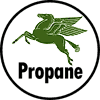 However, not as many people know that propane is commonly used for large corporate vehicle fleets, taxi cabs, and buses. In places like Australia, Denmark, and England, people are converting their cars to run on propane due to the extremely high cost of gasoline in those parts of the world.
However, not as many people know that propane is commonly used for large corporate vehicle fleets, taxi cabs, and buses. In places like Australia, Denmark, and England, people are converting their cars to run on propane due to the extremely high cost of gasoline in those parts of the world. Damn right it is. But if installed and maintained correctly, it's no more dangerous than the gasoline in your car, or for that matter, the electricity and natural gas in your house. In fact, in some ways propane is safer than gasoline. Various crash tests have proven that in a car accident your current gasoline tank is much more likely to rupture and catch fire than a propane tank. This is because propane tanks need to be incredibly strong in order to keep the propane in its compressed, liquefied state for storage. These are burly tanks. If you fired a .22 caliber gun at a propane tank at point blank range you might dent it, but it wouldn't break. Gasoline tanks, on the other hand, are made of thin gauge steel or plastic that can be easily punctured and ripped by hand with a screwdriver. Don't ask me how I know this.
Damn right it is. But if installed and maintained correctly, it's no more dangerous than the gasoline in your car, or for that matter, the electricity and natural gas in your house. In fact, in some ways propane is safer than gasoline. Various crash tests have proven that in a car accident your current gasoline tank is much more likely to rupture and catch fire than a propane tank. This is because propane tanks need to be incredibly strong in order to keep the propane in its compressed, liquefied state for storage. These are burly tanks. If you fired a .22 caliber gun at a propane tank at point blank range you might dent it, but it wouldn't break. Gasoline tanks, on the other hand, are made of thin gauge steel or plastic that can be easily punctured and ripped by hand with a screwdriver. Don't ask me how I know this. I don't see propane as a final solution, but rather as a logical next step. It's a much cleaner burning fuel than gasoline, it's produced in the United States by tapping greater domestic reserves than are available with oil alone, and the millions of cars already on the road can be converted to run on propane relatively cheaply. Electric cars powered by hydrogen fuel cells may one day dominate personal transportation, but all these internal combustion engine cars are still going to be hanging around for many years to come. (Besides, those electric cars aren't likely to replace the sheer aesthetic thrill of blasting down a dirt road in a car that was originally built before the second world war.) The good news is that internal combustion engines aren't all that bad for the environment if they are optimized for cleaner fuels.
I don't see propane as a final solution, but rather as a logical next step. It's a much cleaner burning fuel than gasoline, it's produced in the United States by tapping greater domestic reserves than are available with oil alone, and the millions of cars already on the road can be converted to run on propane relatively cheaply. Electric cars powered by hydrogen fuel cells may one day dominate personal transportation, but all these internal combustion engine cars are still going to be hanging around for many years to come. (Besides, those electric cars aren't likely to replace the sheer aesthetic thrill of blasting down a dirt road in a car that was originally built before the second world war.) The good news is that internal combustion engines aren't all that bad for the environment if they are optimized for cleaner fuels. Propane, on the other hand, is a gas, gas, gas. It doesn't need to atomize, and it doesn't puddle. Propane is only 1.5 times heavier than air, so it can literally hang out all day. And because it stays mixed with the air coming in the intake, all the cylinders get an equal air/fuel mixture. In short, propane makes up for fewer BTUs by burning more efficiently and completely. So the real-world horsepower loss for a propane conversion on an unmodified engine is more like 5%-15%.
Propane, on the other hand, is a gas, gas, gas. It doesn't need to atomize, and it doesn't puddle. Propane is only 1.5 times heavier than air, so it can literally hang out all day. And because it stays mixed with the air coming in the intake, all the cylinders get an equal air/fuel mixture. In short, propane makes up for fewer BTUs by burning more efficiently and completely. So the real-world horsepower loss for a propane conversion on an unmodified engine is more like 5%-15%.